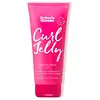What's inside
What's inside
 Key Ingredients
Key Ingredients

No key ingredients
 Benefits
Benefits

 Concerns
Concerns

 Ingredients Side-by-side
Ingredients Side-by-side

Water
Skin ConditioningXanthan Gum
EmulsifyingGlycerin
HumectantPropylene Glycol
HumectantPhenoxyethanol
PreservativeAcrylates/Palmeth-25 Acrylate Copolymer
Parfum
MaskingPEG-40 Hydrogenated Castor Oil
EmulsifyingPolyquaternium-11
Aminomethyl Propanol
BufferingEthylhexylglycerin
Skin ConditioningBenzophenone-4
UV AbsorberCoumarin
PerfumingAlpha-Isomethyl Ionone
PerfumingLinalool
PerfumingCI 17200
Cosmetic ColorantWater
Skin ConditioningPropanediol
SolventGlycerin
HumectantPolyglyceryl-4 Caprate
EmulsifyingAcrylic Acid/Vp Crosspolymer
Polyquaternium-11
Pentylene Glycol
Skin ConditioningPhenoxyethanol
PreservativeParfum
MaskingHydroxypropyltrimonium Hydrolyzed Corn Starch
Panthenol
Skin ConditioningAminomethyl Propanol
BufferingPolyquaternium-70
Simmondsia Chinensis Seed Oil
EmollientCamellia Japonica Seed Oil
EmollientEthylhexylglycerin
Skin ConditioningIsodecyl Neopentanoate
EmollientHydrolyzed Wheat Protein
Skin ConditioningDipropylene Glycol
HumectantHydrolyzed Wheat Starch
Skin ConditioningSodium Chloride
MaskingPotassium Sorbate
PreservativeGlyceryl Caprylate
EmollientGlyceryl Undecylenate
EmollientSodium Hyaluronate
HumectantXanthan Gum
EmulsifyingLimonene
PerfumingLinalool
PerfumingCitral
PerfumingWater, Propanediol, Glycerin, Polyglyceryl-4 Caprate, Acrylic Acid/Vp Crosspolymer, Polyquaternium-11, Pentylene Glycol, Phenoxyethanol, Parfum, Hydroxypropyltrimonium Hydrolyzed Corn Starch, Panthenol, Aminomethyl Propanol, Polyquaternium-70, Simmondsia Chinensis Seed Oil, Camellia Japonica Seed Oil, Ethylhexylglycerin, Isodecyl Neopentanoate, Hydrolyzed Wheat Protein, Dipropylene Glycol, Hydrolyzed Wheat Starch, Sodium Chloride, Potassium Sorbate, Glyceryl Caprylate, Glyceryl Undecylenate, Sodium Hyaluronate, Xanthan Gum, Limonene, Linalool, Citral
 Reviews
Reviews

Ingredients Explained
These ingredients are found in both products.
Ingredients higher up in an ingredient list are typically present in a larger amount.
Aminomethyl Propanol is used to adjust the pH of products. It is also used as a base to create other organic compounds. Having a balanced pH is important for protecting your skin.
Aminomethyl propanol is safe to use in cosmetics up to 1%. It is soluble in water.
Ethylhexylglycerin (we can't pronounce this either) is commonly used as a preservative and skin softener. It is derived from glyceryl.
You might see Ethylhexylglycerin often paired with other preservatives such as phenoxyethanol. Ethylhexylglycerin has been found to increase the effectiveness of these other preservatives.
Glycerin is already naturally found in your skin. It helps moisturize and protect your skin.
A study from 2016 found glycerin to be more effective as a humectant than AHAs and hyaluronic acid.
As a humectant, it helps the skin stay hydrated by pulling moisture to your skin. The low molecular weight of glycerin allows it to pull moisture into the deeper layers of your skin.
Hydrated skin improves your skin barrier; Your skin barrier helps protect against irritants and bacteria.
Glycerin has also been found to have antimicrobial and antiviral properties. Due to these properties, glycerin is often used in wound and burn treatments.
In cosmetics, glycerin is usually derived from plants such as soybean or palm. However, it can also be sourced from animals, such as tallow or animal fat.
This ingredient is organic, colorless, odorless, and non-toxic.
Glycerin is the name for this ingredient in American English. British English uses Glycerol/Glycerine.
Learn more about GlycerinLinalool is a fragrance and helps add scent to products. It's derived from common plants such as cinnamon, mint, citrus, and lavender.
Like Limonene, this ingredient oxidizes when exposed to air. Oxidized linalool can cause allergies and skin sensitivity.
This ingredient has a scent that is floral, spicy tropical, and citrus-like.
Learn more about LinaloolParfum is a catch-all term for an ingredient or more that is used to give a scent to products.
Also called "fragrance", this ingredient can be a blend of hundreds of chemicals or plant oils. This means every product with "fragrance" or "parfum" in the ingredients list is a different mixture.
For instance, Habanolide is a proprietary trade name for a specific aroma chemical. When used as a fragrance ingredient in cosmetics, most aroma chemicals fall under the broad labeling category of “FRAGRANCE” or “PARFUM” according to EU and US regulations.
The term 'parfum' or 'fragrance' is not regulated in many countries. In many cases, it is up to the brand to define this term.
For instance, many brands choose to label themselves as "fragrance-free" because they are not using synthetic fragrances. However, their products may still contain ingredients such as essential oils that are considered a fragrance by INCI standards.
One example is Calendula flower extract. Calendula is an essential oil that still imparts a scent or 'fragrance'.
Depending on the blend, the ingredients in the mixture can cause allergies and sensitivities on the skin. Some ingredients that are known EU allergens include linalool and citronellol.
Parfum can also be used to mask or cover an unpleasant scent.
The bottom line is: not all fragrances/parfum/ingredients are created equally. If you are worried about fragrances, we recommend taking a closer look at an ingredient. And of course, we always recommend speaking with a professional.
Learn more about ParfumPhenoxyethanol is a preservative that has germicide, antimicrobial, and aromatic properties. Studies show that phenoxyethanol can prevent microbial growth. By itself, it has a scent that is similar to that of a rose.
It's often used in formulations along with Caprylyl Glycol to preserve the shelf life of products.
We don't have a description for Polyquaternium-11 yet.
Water. It's the most common cosmetic ingredient of all. You'll usually see it at the top of ingredient lists, meaning that it makes up the largest part of the product.
So why is it so popular? Water most often acts as a solvent - this means that it helps dissolve other ingredients into the formulation.
You'll also recognize water as that liquid we all need to stay alive. If you see this, drink a glass of water. Stay hydrated!
Learn more about WaterXanthan gum is used as a stabilizer and thickener within cosmetic products. It helps give products a sticky, thick feeling - preventing them from being too runny.
On the technical side of things, xanthan gum is a polysaccharide - a combination consisting of multiple sugar molecules bonded together.
Xanthan gum is a pretty common and great ingredient. It is a natural, non-toxic, non-irritating ingredient that is also commonly used in food products.
Learn more about Xanthan Gum